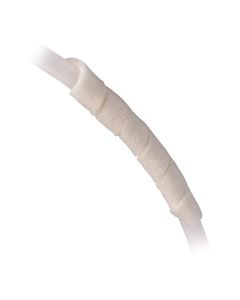


Purpose of Nasal Cannulas
Patients with compromised respiratory health require supplemental oxygen. Some require supplementation 24/7 while others only during high environmental air pollution or dust storms. Whether a temporary or a permanent solution is necessary, oxygen cannulas can be life-saving and increase the quality of life for many.
This article explores who uses cannulas and the various cannula types available for purchase. There is a list of the top-ranking and best-rated nose cannula products, top cannula brands, and the top nose tubing products within their category for life-preserving oxygen therapy.
A nasal cannula is disposable tubing that transfers supplemental oxygen from a concentrator or storage cylinder to someone with a respiratory deficiency. People with oxygen deprivation and those who cannot obtain sufficient oxygen for proper body functioning use this respiratory tubing. Respiration through a nose cannula device is noninvasive ventilation without an endotracheal tube.1
Tube construction consists of a thin vinyl or plastic tubular channel with two prongs on one end inserted into each nostril. The other end of the tubing attaches to an outlet on an oxygen concentrator, liquid oxygen device, or an oxygen storage cylinder.
These medical devices serve two primary functions. First, cannulas provide a channel through which higher concentrations of oxygen gas transition to the patient than typically found in the environment. Secondly, they offer a conduit for an adjustable oxygen flow to the patient. These devices can provide a higher oxygen flow rate than a typical patient's inspiratory flow, allowing the patient to get the level of oxygen they need. These adjustable flows usually range from 0.5 to 10 liters per minute (LPM). Often flows above 6 LPM require a high-flow cannula with larger-diameter tubing to allow increased airflow and improved respiration.
A nasal cannula provides a higher fraction of inspired oxygen (FiO2) to a needy patient. Room air has a FiO2 of 21%. "A nasal cannula set at 1L/min flow rate can increase FiO2 to 24%, 2L/min to 28%, 3L/min to 32%, 4L/min to 36%, 5L/min to 40%, and 6L/min to 44%."2 Increasing the delivery of FiO2 can significantly improve the compromised oxygen patient’s health.
List of the Top Best Oxygen Cannulas Brands [In Rank Order]
- Salter Labs
- Teleflex
- Hudson RCI
- Vaire Medical
- Uni-Flo2
- Medline
- Drive-DeVilbiss
List of the Top Best Nasal Cannula for Oxygen [In Rank Order]
Best Selling Products
Best Nasal Cannulas for Oxygen
#1 Salter Soft Nasal Cannula, 16SOFT
Designed for long-term oxygen therapy patients, the Salter 16SOFT is gentle and soft against the skin. The ergonomic design contours to the patient’s face and stays in place throughout the night. Its plastic construction is very lightweight and nonirritating. This tubing avoids tangling and is stretchable to reduce pressure on the ears and tension on the nose, lips, and face. 16SOFT is a best seller from Salter Labs.
Salter 16SOFT Features
- Soft Tubing Material
- Stretchable
- Resists Tangling and Twisting
- DEHP-Free
- Designed for Long-Term Use
- Flow Capacity: 0 to 6 LPM (Low Flow) and 0 to 15 LPM (High Flow)
- Color: Transparent
- Length Options: 4 Feet, 7 Feet, 14 Feet, 25 Feet
- HCPCS Code: A4615
- Manufacturer: Salter Labs
Salter Labs has two products in the top 12 nasal cannulas. The 16SOFT listed above is first, and the 1600HF is second. The 1600HF is a high-flow oxygen tubing that can accommodate up to 15 LPM. Patients with high-flow oxygen requirements often wear a cumbersome oxygen mask instead of a cannula. However, the design of the Salter 1600 allows for high flow while still offering the comfort and flexibility of a nasal cannula device. The 1600 design anatomically shapes to the face and head of the patient. Curved nasal prongs help to maintain the utmost patient comfort. The user can talk, drink, and eat while still receiving high-flow oxygen.
Salter 1600 Features
- Safety Tubing
- Extremely Comfortable
- Replaces Face Mask for Most Patients
- Soft Material
- Curved Nasal Prongs
- Not Made With Natural Rubber Latex
- Flow Capacity: 0 to 15 LPM (High Flow)
- Color: Transparent or Green
- Length Options: 4 Feet, 7 Feet, 25 Feet, 50 Feet
- HCPCS Code: A4615
- Manufacturer: Salter Labs
#2 Salter 1600, Salter Labs High Flow Nasal Cannula FiO2
The formerly Hudson RCI, now Teleflex SoftTech Plus, is soft and extra flexible for the best user comfort. Its design uses Star-Lumen for crushproof and kinkproof tubing that supports continuous-flow oxygen. Its transparent tubing allows visual inspection. The lariat tubing is green and also employs Star-Lumen technology. The 1870 model comes with 7-foot tubing attached directly to a concentrator, oxygen cylinder, or extension tubing.
Hudson RCI 1870 SoftTech Plus Features
- Soft Durometer Lariat Tubing
- Crushproof
- Kinkproof
- Soft Material
- DEHP-Free
- Flow Capacity: 0 to 4 LPM (Low Flow)
- Color: Transparent With Green Lariat
- Length Options: 7 Feet
- HCPCS Code: A4623
- Manufacturer: Teleflex (Formerly Hudson RCI)
#3 Hudson RCI SoftTech Plus 1870
#4 Teleflex 1103 Over-the-Ear Nasal Cannula
Teleflex 1103 is an over-the-ear design that supports user comfort. Its soft vinyl construction offers a consistent airflow for needy patients. The 1103 comes with non-flared prongs positioned on a contoured lip tab where it comfortably rests below the patient's nostrils. The tubing is transparent, allowing visual inspection. The tubing is also crush resistant and kink resistant to provide uninterrupted service.
Teleflex 1103 Over-the-Ear Features
- Soft Vinyl Tubing
- Crush-Resistant
- Kink-Resistant
- Continuous-Flow Support
- Curved Prong
- Non-Flared Prongs
- Flexible Lip Tab
- Not Made With Natural Rubber Latex
- DEHP-Free
- Flow Capacity: 0 to 7 LPM (Low to Medium Flow)
- Color: Transparent
- Length Options: 7 Feet
- HCPCS Code: A4615
- Manufacturer: Teleflex (Formerly Hudson RCI)
#5 AirLife 2600 Cannula
AirLife 2600 construction consists of PVC that is soft and comfortable. The design helps prevent skin irritation and chafing. The tubing is crush-resistant to prevent kinking and airflow stoppage. Lariat tubing is also soft, and the nasal prong support is of a clear cushion design for a comfortable fit under the nostrils and on top of the upper lip.
AirLife 2600 Over-the-Ear Features
- Flared or Non-Flared Prongs
- Crush-Resistant
- Kink-Resistant
- Disposable
- Flexible Lip Tab
- Soft Touch
- Over-Ear
- Material: PVC
- Not Made With Natural Rubber Latex
- Flow Capacity: Low Flow
- Color: Clear
- Length Options: 7 Feet, 25 feet
- HCPCS Code: A4623
- Manufacturer: Vyaire Medical
#6 Uni-Flo2
Uni-Flo2 is lightweight oxygen tubing that delivers 0 to 6 LPM of continuous oxygen. Manufactured with medical-grade plastic, the Uni-Flo2 device is lightweight, weighing only half of the standard tubing. Its lightweight makes it less intrusive, more stable, and highly comfortable. The Vortex design accommodates more oxygen uptake, and the single-prong construction is the least invasive of the top 12. This design offers multiple relief points that allow day and night continuous flow.
Uni-Flo2 Features
- Single Prong Design
- Lightweight
- 50% Less Plastic
- Low Profile
- Ergonomic
- Material: PVC
- No Added DEHP
- Flow Capacity: 0 to 6 LPM
- Color: Clear
- Length Options: 7 Feet
- HCPCS Code: A4615
- Manufacturer: UPODS, LLC
#7 Hudson RCI SoftTech 1820
SoftTech 1820 utilizes Star Lumen tubing with either a standard or universal tubing connection. It is also available without tubing (item number 1821). Featuring soft construction, the 1820 is user-friendly with a traditional over-the-ear design. Its lightweight construction makes it less noticeable to the ears and cheeks of the user. Flexible nasal prongs add extra comfort.
SoftTech 1820 Features
- Star Lumen Lariat Tubing
- Crushproof
- Kinkproof
- Lightweight
- DEHP-Free
- Flow Capacity: 0 to 6 LPM (Low Flow)
- Color: Clear
- Length Options: 4 feet, 7 Feet, 25 Feet
- HCPCS Code: A4615
- Manufacturer: Teleflex (Formerly Hudson RCI)
#8 Teleflex SofTech Plus Pediatric 1871
SofTect Plus 1871 construction includes soft Star Lumen construction designed for pediatric (1871), infants (1872), and neonatal (1873). This construction with soft materials is for the comfort of the users. A notch placed in the lip tab provides additional flexibility and a customized fit for extra comfort. The tubing is green to increase visibility and to help reduce connection errors.
SoftTech 1871 Features
- Soft Durometer Tubing
- Star Lumen Construction
- Crushproof
- Kinkproof
- Lightweight
- DEHP-Free
- Flow Capacity: Low Flow
- Color: Green
- Length Options: 7 Feet
- HCPCS Code: A4615
- Manufacturer: Teleflex (Formerly Hudson RCI)
#9 AirLife ETCO2 Sampling Cannula
Vyaire AirLife ETCO2 Sampling Cannula provides oxygen to one nostril while sampling CO2 from the other for an accurate ETCO2 reading. Its construction includes a permanent barrier separating the nasal prongs. Soft, 7-foot tubing is comfortable for the user. This AirLife product is available in adult and pediatric sizes with Luer-Lok connections.
AirLife ETCO2 Sampling Features
- ETCO2 Sampling
- Crush-Resistant
- Kink-Resistant
- Disposable
- Soft Tubing
- Curved Prongs
- DEHP-Free
- Not Made With Natural Rubber Latex
- Flow Capacity: Low Flow
- Color: Clear Cannula, Green Tubing
- Length Options: 7 Feet
- HCPCS Code: A4623
- Manufacturer: Vyaire Medical
#10 Medline Soft-Touch
Medline Soft-touch is available for adults, pediatrics, and infants. It comes with standard and universal connector options. Tubing lengths of 7, 14, and 25 feet offer a variety of options for users. Curved nasal prongs provide a natural fit that contours to the nasal passageway. The prong tips are soft and adequate for extended oxygen service. Top-selling Soft-Touch products include the Medline HCS4504B (4 Foot Tubing with Standard Connector) and the Medline HCS4514 (7 Foot Tubing with Standard Connector).
Medline Soft-Touch Features
- Soft Materials
- Standard and Universal Connectors
- Crush-Resistant
- Disposable
- Soft Tubing
- Curved, Non-Flared Prongs
- Material: PVC
- Flow Capacity: Low Flow
- Color: Clear Cannula
- Length Options: 4 feet, 7 Feet, 14 Feet, 25 Feet
- HCPCS Code: A4623
- Manufacturer: Medline
#11 McKesson ETCO2
McKesson ETCO2 is sampling nasal cannula for measuring patient CO2 exhalation. It provides for simultaneous O2 inhalation and end-tidal gas sampling. It provides for simultaneous O2 inhalation and end-tidal gas sampling. The tubing is soft to the skin and is kink-resistant. A Luer-type connection on the end of the tubing provides added security.
McKesson ETCO2 Sampling Cannula Features
- Soft Materials
- Standard and Universal Connectors
- Kink-Resistant
- Disposable
- Soft Tubing
- Curved, Non-Flared Prongs
- Material: Plastic
- Not Made With Natural Rubber Latex
- Flow Capacity: Low Flow
- Color: Clear Cannula, Green Tubing
- Length Options: 7 Feet, 10 Feet
- HCPCS Code: A4623
- Manufacturer: McKesson
#12 CHAD Oxymizer Conserver
CHAD Oxymizer Conserver from Drive Medical is a disposable oxygen conserver available in two distinct styles: Mustache or Pendant. The Mustache Oxymizer is a fluidic oxymizer with a capacity flow of 20 LPM, while the Pendant Oxymizer has a flow capacity of 15 LPM. These conserver cannulas offer a savings ratio of 4:1, which can significantly preserve breathing oxygen for the patient that would otherwise be wasted. Oxymizers help users reach proper O2 saturation. When placed under clothing, the Pendant Oxymizer offers inconspicuous wear. Both devices use silicone materials in their construction.
Drive CHAD Oxymizer Conserver Features
- Lightweight
- Maximizes Oxygen Use
- Disposable
- Material: Silicone
- Not Made With Natural Rubber Latex
- Flow Capacity: High Flow
- Color: Clear
- HCPCS Code: A4649
- Manufacturer: Drive Medical
Top Ranking Cannula by Category
Best Pediatric Cannula
Best Adult Cannula
Best Soft Nasal Cannula
Best ETCO2 Cannula
Best Conserving Cannula
Nasal Cannula Indications
- Hypoxemia
- Pneumonia
- Asthma
- Croup
- Bronchitis
- Post-Extubation
- Pre-Oxygenation Before Intubation
- Acute Pulmonary Edema
- Non-Intubation Patients
- Non-Resuscitating Patients
- Respiratory Failure3
Nasal Cannula Contraindications
- Hypercapnia
- Nonconsenting Patients
- Uncooperative Patients
- High Aspiration Risk
- Complete Airway Obstruction
- Facial Trauma
- Basal Skull Fracture4, 5


Types of Nasal Cannulas
Cannula types include differences in nasal tips and the inside diameter of the tubing. The larger the diameter, the increased oxygen flow.6
Some patients require higher oxygen flows, but usually at the expense of nasal and airway passage dryness. Mitigation of the dryness effect through humidification is often a remedy in these cases.
Nasal tips come in four common types: curved, straight, flared, and non-flared. The curved and straight designs affect patient comfort preferences while flared tips support pulse-demand oxygen delivery, particularly with large nostril patients. Most oxygen patients function well with non-flared tips. The graphics on the right depict the different types.
Cannula Nasal Tip Types
Curved
Straight
Flared
Non-Flared
Cannula Flow Types
Low – 0 to 4 LPM
Standard – 0 to 6 LPM
High – Above 6 LPM
Cannula Color Types
Clear – or invisible nasal cannula is transparent and easy to inspect for obstructions or condensation. However, transparent tubing can sometimes be challenging to see and become a tripping hazard
Green – cannula offers high visibility and is less of a tripping hazard.
Summary
People with oxygen deprivation can experience a better quality of life and a longer life with supplement oxygen. Nasal cannulas are a conduit for oxygen and healthier outcomes. This article explored who needs these devices, the different types of cannulas, and how to select the top best nasal cannula for individual needs. The article also presented the top best nasal cannula products on the market for oxygen therapy.
Footnotes
- 1 Guia, Miguel, et al. The role of non-invasive ventilation in weaning and decannulating critically ill patients with tracheostomy: A narrative review of the literature. Pulmonology 27.1 (2021): 43-51. (2021). Accessed 24 Jan. 2022.
- 2 Fuentes, Stepfany, and Yuvraj S. Chowdhury. Fraction of inspired oxygen. StatPearls [Internet] (2021). Accessed 18 Jan. 2022.
- 3 Lodeserto, Frank J., Thomas M. Lettich, and Salim R. Rezaie. High-flow nasal cannula: mechanisms of action and adult and pediatric indications. Cureus 10.11 (2018). Accessed 20 Jan. 2022.
- 4 Kotwinski D, Paton L, Langford R. The role of high flow nasal oxygen therapy in anesthesia. British Journal of Hospital Medicine. 2018 Nov 2;79(11):620-7. Accessed 20 Jan. 2022.
- 5 Brennan, V., et al. Oxygen Therapy in the Elderly: When Nasal Cannula Is Not Enough. Current Geriatrics Reports 5.4 (2016): 283-288. Accessed 20 Jan. 2022.
- 6 Pinkham, Maximilian, and Stanislav Tatkov. Effect of flow and cannula size on generated pressure during nasal high flow." Critical Care 24 (2020): 1-2. Accessed 20 Jan. 2022.





Login and Registration Form